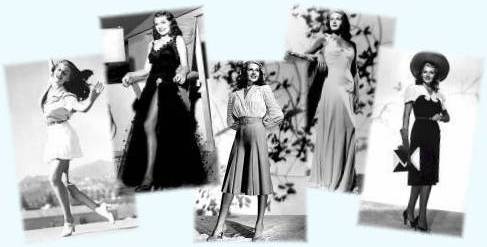
| When Rita's career first began, in the mid 30's, she was of course not yet having clothes specially made for her, but she was taking the first steps toward becoming a glamour girl. During her days at Fox and the start of her career at Columbia Pictures she went through the standard process of spending hours in the portrait gallery having her picture taken in various swim suits and the studio's loveliest gowns. A designer named Robert Kalloch created Rita's first specially designed wardrobe at Columbia, for the film The Lone Wolf Spy Hunt (see a gown from the film above, second on the left). Then in 1940 she received a major publicity coup when her press agent got her named "Best Dressed Girl in Hollywood" by a prestigious publication of the time, Look magazine. Other instances of her gaining notoriety on the basis of her fashion model talents include Life magazine spreads of her modeling "The World's Most Costly Gown" (pictured on the right end) and trying out the latest styles in swim wear. Of course this was all just publicity to get her name before the public, but unquestionably even early on, wearing beautiful clothes was a big part of her image. |

| Travis Banton (famous for his designer-star collaboration with Marlene Dietrich during the 30's), was the man assigned the task of designing Rita's gowns for the film that made her a bonafide star, Blood and Sand. Making full use of the vibrant Technicolor of the 40's, Banton's standout creation for the movie was a form-fitting Spanish-style red/dark pinkish dress, which Rita wore during her sizzling matador dance with Anthony Quinn. Banton's other costumes for Blood and Sand were stunning as well, helping to set the mood for the film and also helping to transform the usually shy Rita into the sultry femme fatale she played on screen. |

| Rita was given the chance to strut her stuff with Fred Astaire for the first time in You'll Never Get Rich. Designer Robert Kalloch, who had worked on many of her early Columbia films, was chosen to decide what clothes Rita would do this strutting in. The standouts were in your basic colors, black and white -a beautiful white gown she wears all too briefly in the nightclub scene and the black dress from the "So Near and Yet So Far" number. The rest of the smart and sassy Sheila Winthrop's wardrobe is also lovely and showed how a modern, fashionable early 40's woman should dress. |

| My Gal Sal was a period musical set in turn-of-the-century New York, so Gwen Wakeling was a natural choice to design the costumes for the film. In Hollywood's Golden Era, period costumes seem to have been her specialty. In her creations she used bold colors- flamingo pink, gold, red- putting the film's Technicolor to good use, and extravagant styles- adding to the gaiety of the gay 90's! |

| Irene's designs for You Were Never Lovelier were incredibly sexy. She used lace, flesh-colored tones and displayed her mastery of illusion in Rita's gowns. She could give some of today's stylists a lesson in just how sexy a gown can be, without revealing a thing. Using suggestively placed jewels, sparkles, lace and embroidery, her gowns created the illusion that you were seeing more than you were actually seeing. You Were Never Lovelier is among my picks for all-time most fashionable films. |

| As you've just read further up on this page, Travis Banton and Gwen Wakeling had worked on other Rita films in the past, they were two of Hollywood's top designers, so it's not surprising that they were called in to work with her again for Cover Girl (along with Muriel King). In the film Rita played dual characters- Rusty Parker, a modern day beauty for whom Travis Banton's latest fashions were required- and Rusty's grandmother, Maribelle, who would need the imagination of Gwen Wakeling to help her look the part of a turn-of-the-century singer and dancer. |

| As you see, onscreen, Rita was always impeccably groomed. Off the screen however, is another story all together. For Rita, being dressed to the nines was an aspect of her job, not part of who she really was. When she didn't have to play movie star, Rita felt most at home in a pair of slacks or baggy jeans, a comfortable sweater and penny loafers. But even though she loved to dress very casually as often as she could get away with it, she also knew how and when to glam it up for public appearances. For example, at the end of a trans-Atlantic voyage where photographers were always sure to be to snap candid shots of the movie star. The third picture in on the left shows a beautifully groomed Rita on board the Queen Elizabeth upon arrival in the U.S., and the two at far right show Rita decked out for the premiers of Down to Earth and Salome, respectively. Pictured third from the end on right is perhaps Rita's most famous off-screen dress, the one she wore when she married Prince Aly Khan. It was a lovely pale blue crepe Jacques Fath creation so widely admired that copies of the gown made it to Macy's department store where women could purchase their very own replica of Rita's wedding dress. |
|
As I said before, "The Rita Hayworth Fashion Page" is actually three pages. In the next two parts you'll read about and see the contributions made by designer Jean Louis to the on-screen wardrobe of Rita's most famous films.
|